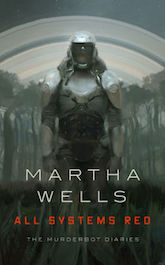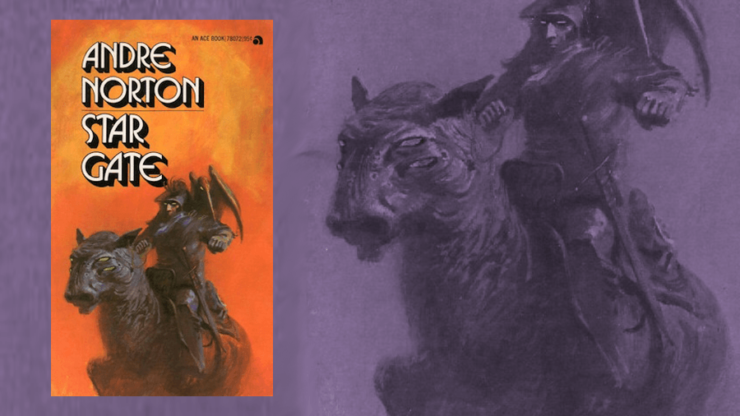One of my absolute favorite books when I was a kid in the 70s was Star Gate by Andre Norton, published in 1958. I found it first in the junior high school library, then managed to buy a used paperback copy—probably secretly; my father didn’t believe in letting me buy books I’d already read, even when they were only $1.00 or so. Even as a kid I was careful with books no matter how many times I read them, and it’s on my shelf today.
It’s one of those books that I didn’t realize was deeply encoded in my writing DNA until I went back and looked at it recently. It’s not like I ever forgot about the book, but it and the others like it were so deep under my skin I forgot there was a time before I read them. They formed my understanding of what SF/F should be. I read Tolkien and other epic fantasies, but Andre Norton got to me first, and planted seeds that eventually grew into mountain-trees.
Despite the title, Star Gate doesn’t feel like an influence on the modern day Stargate movie or TV series (of which I’m also a huge fan). As Judith Tarr observes in her Andre Norton Reread Series, Exiles of the Stars shares more of the same themes.
In Norton’s Star Gate, the Star Lords, members of an advanced culture fleeing their own dying planet, have landed on Gorth, an inhabited pre-technological world. The Star Lords are peaceful refugees who don’t want to invade, but their starships can’t take off again, and they’ve been stuck on Gorth for years. The Star Lords look different enough from the native Gorthians to stand out (the Star Lords are tall and dark-skinned while the Gorthians are short and light-skinned) but they’ve intermarried and had lots of babies.
After a long time getting along together, the political climate has turned drastically against the Star Lords, and they know they need to leave Gorth so its civilization can develop on its own, without their help or interference. They’ve been experimenting with a way to use a dimensional portal to travel to a parallel universe where intelligent life never developed on Gorth. It would be the planet they’ve come to love, but uninhabited.
Main character Kincar discovers his father was a Star Lord, and has to leave Gorth with them and their other Gorthian/Star Lord children. But the Star Lords have to leave in a hurry and they end up in the wrong version of Gorth. They’ve stumbled on a parallel universe inhabited by their exact duplicates, but with a twist. On this version of Gorth, instead of tired refugees looking for a place of safety, the Star Lords were evil invaders bent on conquest. They even encounter and have to fight their own evil counterparts. Yes, it’s just like that Star Trek episode where Spock has a beard. Andre Norton got there first, too.
I was a kid when I first found SF/F and Andre Norton, hungry for stories I could relate to, and Star Gate was one of the first books by her that I read. Most of Norton’s books were written for adults, but many were perfect for younger teenagers and she had a whole shelf in the junior high school library.
This was in the ’70s, long before YA was a category, and in the children’s section of the library it felt like I had been swimming in books where only boys could have adventures. Sometimes the girls seemed to be only present as babysitters or anchors to drag the story down. Norton’s books, and the other SF/F her books led me to, were different.
Despite the fact that a lot of Norton’s stories and worlds, especially her early books from the ’40s and ’50s, were male-centric, she wrote a lot of great active female characters. They were sorcerers, leaders, explorers, warrior-queens, and they were often pictured on the bright paperback book covers, attracting me like a magnet.
Buy the Book


All Systems Red: The Murderbot Diaries
She also had Native American protagonists who went to other planets or became time travelers, and African American protagonists who found portals to other worlds. She used a variety of settings, like Egypt under the Hyksos, the Beaker Culture of Bronze Age Britain, and Meroë in the Kingdom of Kush, for historical fantasy, time travel stories, or secondary fantasy worlds with science fictional technology.
Norton’s Star Gate might technically be science fiction, but like a lot of her books, it feels like a blend of SF and fantasy. Gorth is a sword and sorcery world that’s visited by science fiction rockets. And like Star Gate, a lot of her books feature characters who start out in one strange secondary world only to be transported to somewhere even stranger. I loved that. She created worlds where anything could happen.
There weren’t a lot of boundaries in her books and many didn’t fit neatly into a single category. Your main character might start out in a science fiction dystopia and end up in an alien body, fighting an epic fantasy war. Your sword and sorcery adventurers might have to fight aliens and your space-faring explorers might run into gods and wizards. It paved the way for me to fall head over heels in love with Star Wars. (Spaceships and mystical Jedi Knights with mind powers and ancient weapons is all very Norton, when you think about it.)
In Star Gate, Kincar is a bit of an outsider who gets dragged out of his normal life, told he doesn’t really belong in his home, and has to flee to another dimension with the space relatives he’s just met. Norton’s main characters were often people who had been ripped out of the life they had expected to have, who were set apart or isolated in some way, who were desperately searching for a place to belong. This was also terribly attractive to the kid I was at the time. Her male characters felt a lot more relatable to me than those in other books. There were none of the brash confident boys sneering at their incompetent or bossy sisters.
These were the kinds of SF/F books I grew up reading in the 70s, went to college reading in the 80s, that inspired me to write. Books like The Door into Shadow by Diane Duane, Imaro by Charles Saunders, Tomoe Gozen by Jessica Amanda Salmonson, Zelde M’tana by F.M. Busby, books by Tanith Lee, Barbara Hambly, Phyllis Gotlieb, P.C. Hodgell, Judith Tarr, Janet Kagan, Nancy Springer.
Because of these books, I never thought of fantasy as being exclusively derivative of Tolkien. I saw fantasy and science fiction as a continuum where books might occur on any point in between. And it existed in a world where most of the writers were women.
Originally published in May 2017.
Martha Wells is a science fiction and fantasy writer, whose first novel was published in 1993. Her most recent books include The Murderbot Diaries—All Systems Red, Artificial Condition, Rogue Protocol, and Exit Strategy—for Tor.com. Besides many fantasy novels, she has also written short stories, media tie-ins for Star Wars and Stargate Atlantis, YA fantasies, and non-fiction.










